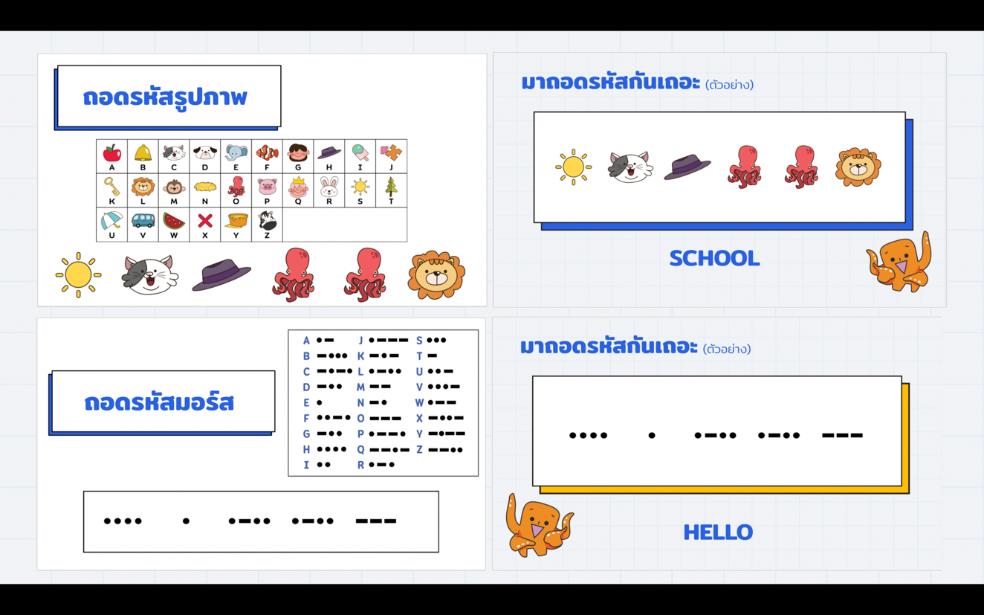Integrating Coding into Education
Keywords:
Integrated instruction, Coding, Computational thinking skillsAbstract
Understanding coding is not limited to just thinking like a computer or to the science of computer scientists alone. It also covers the use of commands or symbols that indicate the sequence of steps needed to perform a desired task. The importance of coding is not only about enabling humans to command computers, but it is also an analytical thinking process that can be used to solve human problems. Integrating coding into education is one way to help learners develop their interconnected thinking, analytical thinking, and computational thinking skills, which are important problem-solving skills that involve reasoning and logic. This can help promote the learners' ability to see the relationship between each subject's content and coding, which is crucial knowledge for solving complex problems and adapting to rapidly changing technology.
References
Burning Class. Beyond point and click: The expanding demand for coding skills [Internet]. 2016 [cited 2022 March 10]. Available from https://academy.oracle.com/pages/Beyond_Point_Click_final.pdf
Holvikivi J. Conditions for successful learning of programming skills. IFIP International Conference on Key Competencies in the Knowledge Society. Berlin: Heidelberg; 2010: 155-164.
สำนักงานคณะกรรมการการศึกษาขั้นพื้นฐานกระทรวงศึกษาธิการ. ตัวชี้วัดและสาระการเรียนรู้แกนกลาง กลุ่มสาระการเรียนรู้วิทยาศาสตร์ (ฉบับปรับปรุง พ.ศ. 2560) ตามหลักสูตรแกนกลางการศึกษาขั้นพื้นฐาน พุทธศักราช 2551. กรุงเทพฯ: โรงพิมพ์ชุมนุมสหกรณ์การเกษตรแห่งประเทศไทย จำกัด. 2560.
ธิติวัฒน์ ทองคำ. การพัฒนากิจกรรมการจัดการเรียนรู้วิทยาการคำนวณแบบผสมผสานร่วมกับวิชวลโปรแกรมมิ่ง เพื่อส่งเสริมกระบวนการคิดเชิงคำนวณสำหรับนักเรียนชั้นประถมศึกษาปีที่ 5 ในโรงเรียนสังกัดสำนักงานเขตพื้นที่การศึกษาประถมศึกษาเพชรบุรีเขต 1 [วิทยานิพนธ์ปริญญามหาบัณฑิต]. นครปฐม: มหาวิทยาลัยศิลปากร; 2563.
Mirit S, Kocherovsky M, Chung CJ. A paradigm for teaching math and computer science concepts in k-12 learning environment by integrating coding, animation, dance, music and art. Proceedings of the IEEE Integrated STEM Education Conference (ISEC); 2019 Mar 16; Princeton, NJ: USA; 2019
Campbell C, Henning M. Planning, teaching, and assessing elementary education interdisciplinary curriculum. International Journal of Teaching and Learning in Higher Education 2010;22(2):179-86.
สำนักงานเลขาธิการสภาการศึกษา. ถอดบทเรียนกิจกรรมการเรียนการสอน CODING และการสร้างสรรค์นวัตกรรม: การพัฒนาผู้เรียนให้มีคุณลักษณะที่พึงประสงค์ของคนไทย 4.0 ตามมาตรฐานการศึกษาของชาติ. กรุงเทพฯ: บริษัท 21 เซนจูรี่ จำกัด; 2563.
กระทรวงศึกษาธิการ. ตัวชี้วัดและสาระการเรียนรู้ กลุ่มสาระการเรียนรู้ภาษาวิทยาศาสตร์และเทคโนโลยี ตามหลักสูตรแกนกลางการศึกษาขั้นพื้นฐาน พุทธศักราช 2551. พิมพ์ครั้งที่ 1. กรุงเทพฯ: โรงพิมพ์ชุมนุมสหกรณ์การเกษตร แห่งประเทศไทย จำกัด; 2560.
The matter. การศึกษาไทยในยุคที่โลกหมุนไปด้วยการโค้ด [อินเตอร์เน็ต].[เข้าถึงเมื่อวันที่ 10 มีนาคม2565].เข้าถึงได้จาก https://thematter.co/wp-content/uploads/20 21/03/Coding-Ebook.pdf
Blikstein P, Krannich D. The makers' movement and FabLabs in education: Experiences, technologies, and research. Proceedings of the 12th International Conference on interaction design and children; 2013 Jun 24-27; New York: USA; 2013. p. 613-6.
Vahtivuori-Hänninen S, Halinen I, Niemi H, Lavonen J, Lipponen L. A new Finnish national core curriculum for basic education (2014) and technology as an integrated tool for learning. In: Niemi H, Multisilta J, Lipponen L, Vivitsou M, editors. Finnish Innovations and Technologies in Schools; 2014. p. 21-32.
สถาบันส่งเสริมการสอนวิทยาศาสตร์และเทคโนโลยี (สสวท.). คู่มือการใช้หลักสูตรรายวิชาพื้นฐานวิทยาศาสตร์กลุ่มสาระการเรียนรู้วิทยาศาสตร์ (ฉบับปรับปรุง พ.ศ.2560) ตามหลักสูตรแกนกลางการศึกษาขั้นพื้นฐานพุทธศักราช 2551 สาระเทคโนโลยี (วิทยาการคำนวณ) ระดับประถมศึกษาและมัธยมศึกษา[อินเตอร์เน็ต]. 2561 [เข้าถึงเมื่อวันที่ 10 มีนาคม 2565]. เข้าถึงได้จาก:https://www. scimath.org/.
ทิศนา แขมมณี. ศาสตร์การสอน: องค์ความรู้เพื่อการจัดกระบวนการเรียนรู้ที่มีประสิทธิภาพ. พิมพ์ครั้งที่ 5. กรุงเทพฯ: สำนักพิมพ์แห่งจุฬาลงกรณ์มหาวิทยาลัย; 2550.
ปัฐมาภรณ์ พิมพ์ทอง. การจัดการเรียนรู้สะเต็มศึกษา. พิมพ์ครั้งที่ 2. กรุงเทพฯ: วิสต้า อินเตอร์ปรินท์; 2564.
Coding Thailand. กิจกรรม การเข้ารหัสข้อมูลเบื้องต้น [อินเตอร์เน็ต]. 2564 [เข้าถึงเมื่อวันที่ 10 มีนาคม2565].เข้าถึงได้จาก: https://codingthailand.org/
สถาบันส่งเสริมการสอนวิทยาศาสตร์และเทคโนโลยี (สสวท.). คู่มือครูรายวิชาพื้นฐานวิทยาศาสตร์ชั้นมัธยมศึกษาปีที่ 4 เทคโนโลยี (วิทยาการคำนวณ) ตามมาตรฐานการเรียนรู้และตัวชี้วัดกลุ่มสาระการเรียนรู้วิทยาศาสตร์ (ฉบับปรับปรุง พ.ศ.2560) ตามหลักสูตรแกนกลางการศึกษาขั้นพื้นฐานพุทธศักราช 2551. [อินเตอร์เน็ต]. 2563 [เข้าถึงเมื่อวันที่ 10 มีนาคม2565].เข้าถึงได้จาก:https://www.scimath.org/.

Downloads
Published
Issue
Section
License
บทความทุกบทความที่ตีพิมพ์ในวารสารการพัฒนางานประจำสู่งานวิจัย (JPR2R) ถือว่าเป็นลิขสิทธิ์ของวารสารการพัฒนางานประจำสู่งานวิจัย คณะสิ่งแวดล้อมและทรัพยากรศาสตร์ มหาวิทยาลัยมหิดล





